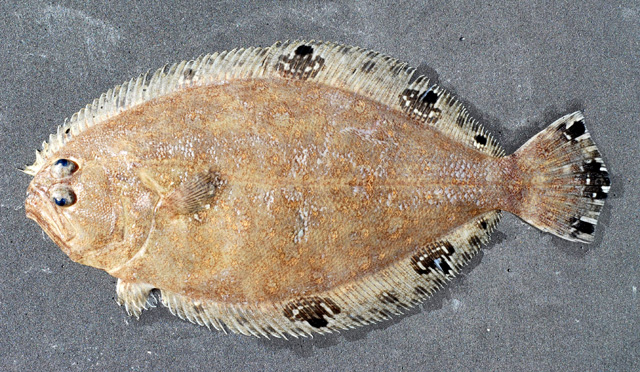| Cyclopsettidae (Sand whiffs) |
| 32 cm TL (male/unsexed); max.weight: 371.3 g |
|
demersal; marine; depth range 20 - 150 m |
| Western Atlantic: northwestern Gulf of Mexico to Brazil. |
|
Dorsal spines (total): 0-0; Dorsal soft rays (total): 82-90; Anal spines: 0-0; Anal soft rays: 63-69. Body is oval, moderately elongate. Dorsal fin originates distinctly anterior to a vertical at front of the eyes. Eyes on left side, not large, their diameter is 5 - 5.9 times the head length. The interorbital space is narrow, less than half the eye diameter. Lateral line on eyed side is not steeply arched above pectoral fin. The mouth is large extending slightly beyond the posterior margin of the eyes. Caudal fin is rounded. Color is brown with a large blotch beneath pectoral fin. The dorsal and anal fins have a row of dark spots containing pale areas,. Two spots on the dorsal and a few on the anal are large. The caudal fin has three large dark spots at the posterior border, none on center of the fin. Number of ovaries: 2. Ovaries are symmetrical, lie parallel with each other, depressed cross-sectionally and extra-visceral in location (Ref. 101557). |
| Occurs in bays, lagoons and shallow coastal waters. Found on soft bottoms (Ref. 5217). Marketed fresh (Ref. 5217). |
|
Least Concern (LC); Date assessed: 13 February 2021 Ref. (130435)
|
| harmless |
Source and more info: www.fishbase.org. For personal, classroom, and other internal use only. Not for publication.

